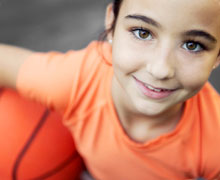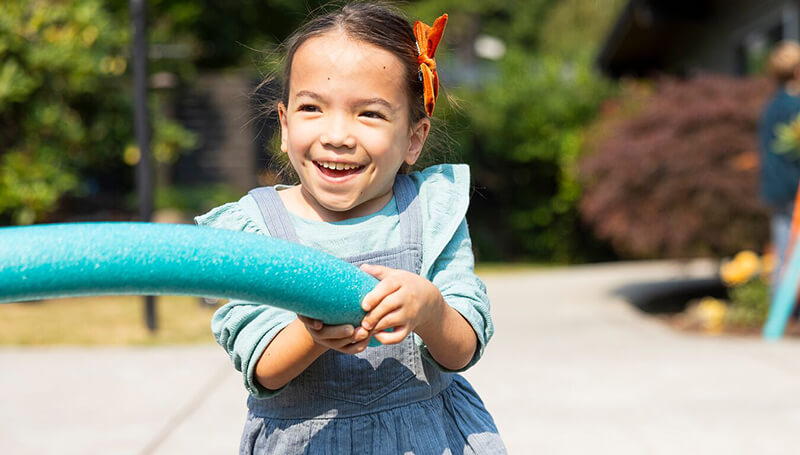Exercise and Children: Helping Your Child Move Their Body

Do children and teens get enough exercise?
Most American kids and teens 6 and older do not get enough exercise each day. There are many reasons for this, including increased screen time, busy lifestyles and changes such as more traffic and less open spaces in which to play.
We also know that nearly 1 in 3 children in the United States are overweight, and that children and teens become less active every year they get older.
How much exercise or active play does my child need?
Preschoolers need lots of active play time. For this age, the goal is at least 2 hours (120 minutes) of active play each day. Your preschooler should play every hour throughout the day for about 15 minutes at a time.
Grade-school children and teens need to be active at least 60 minutes each day. Getting more than an hour is good, too. The 60 minutes do not have to be all at one time. It’s OK to break the activity into 10- or 15-minute segments.
A variety of activities is best. Help your child choose aerobic, muscle-strengthening and bone-strengthening activities that are right for their age and development.
- Aerobic exercise: Running, bicycling, hiking, tag, jumping rope, martial arts, basketball, swimming, tennis, skateboarding, dancing, sweeping, soccer
- Muscle-strengthening exercise: Push-ups, sit-ups, rope climbing, swinging on monkey bars, tug-of-war, rock climbing, weight lifting, resistance exercises, gymnastics
- Bone-strengthening exercise: Hopping, skipping, jumping, running, basketball, tennis, volleyball, gymnastics
What are the benefits of being active?
- Increased confidence.
- Increased strength and coordination.
- Reduced stress.
- Better sleep at night, more alert during the day and better performance in school.
- Weight control and decreased risk of diabetes, heart disease and other health conditions.
- Lifelong fitness and living longer.
- Having fun doing activities you enjoy!
How can I help my child get more exercise or active play?
Make changes in your daily routine to include exercise for your whole family. Remember that your children see you as the model; they will do what you do. Try these ideas:
- Walk to school with your child. If it’s too far to walk, drive to within a 15-minute walking distance, park the car and walk the rest of the way. Use the time to talk with your child.
- Instead of turning the TV on or using other screens after dinner, play catch or take a walk together. The more time kids spend in front of a screen, the less time they spend being active.
- Set up a silly obstacle course in your yard or at a nearby park.
- Get everyone to help with cleaning the house, yard work and washing the car.
- Have family play time one night a week. Kids and parents can take turns choosing things the whole family can do. Some ideas are swimming, biking, dancing or playing tag in the yard. Use your local park, pool or community center.
- Plan outings that involve walking, like a trip to the park or zoo.
- When gift-giving, select presents that promote movement, such as a Frisbee, ball, jump rope, scooter, skates, bike or helmet.
- Check out family-friendly workouts on YouTube.
- Learn about activities offered by organizations like YMCA, Boys and Girls Club, and others. Ask about scholarships if you need help paying.
Tips for success
- Include your kids in planning.
- Stress fun, not skill.
- Always use the right clothes and equipment for safety and comfort.
- Drink plenty of water before, during and after being active. Sports drinks aren’t needed; plain water is best.
- Include warm-ups and cool-downs as part of your exercise.
- For older kids, keep a diary of physical activities to be sure 60 minutes is met each day. Include time your child spends in PE and at recess.
- If you have a child with special needs, involve them in the activities, too. They may require extra time and support.
- If your child is overweight or not used to exercise, be patient and offer support. Start with small easy and enjoyable activities to slowly build confidence, skill and stamina. Do things they want to try. Talk with your healthcare provider to help you and your child get started on a fitness program.
- Make small changes to increase activity, like taking the stairs and running errands on foot or by bicycle.
- Try activities that might be new to your family, like Zumba, canoeing, yoga, rock climbing or urban geocaching.
To Learn More
Talk with your child's healthcare provider or read Healthy Eating Habits.

